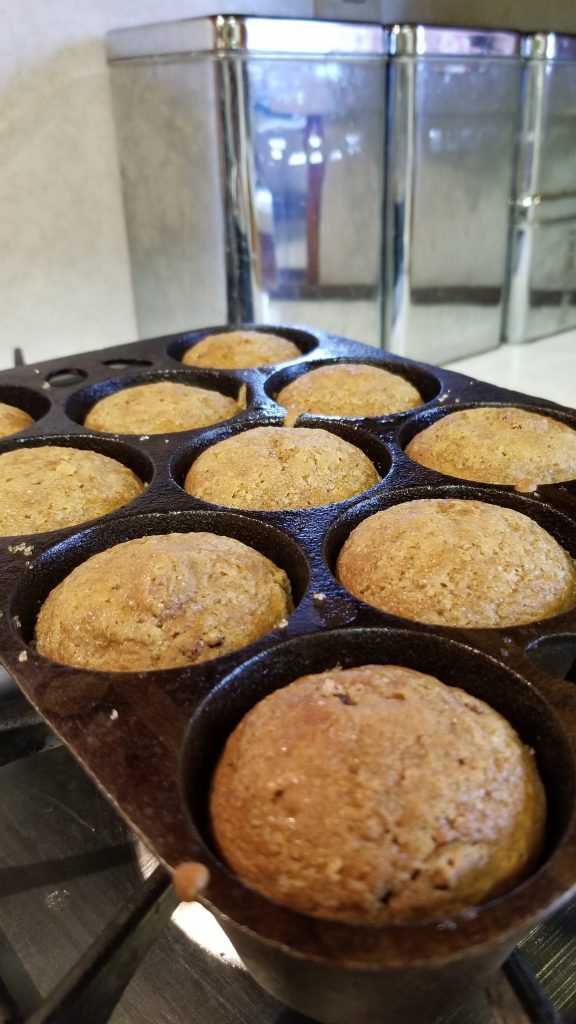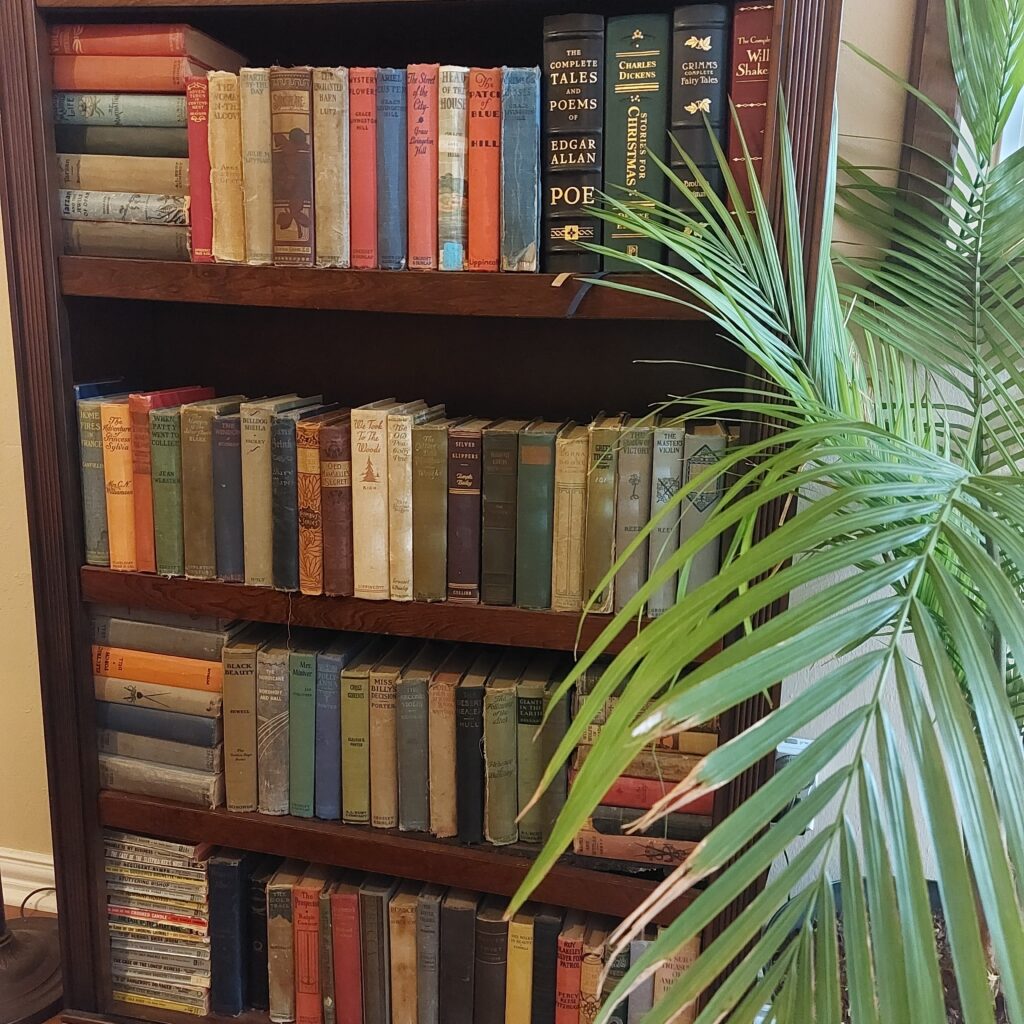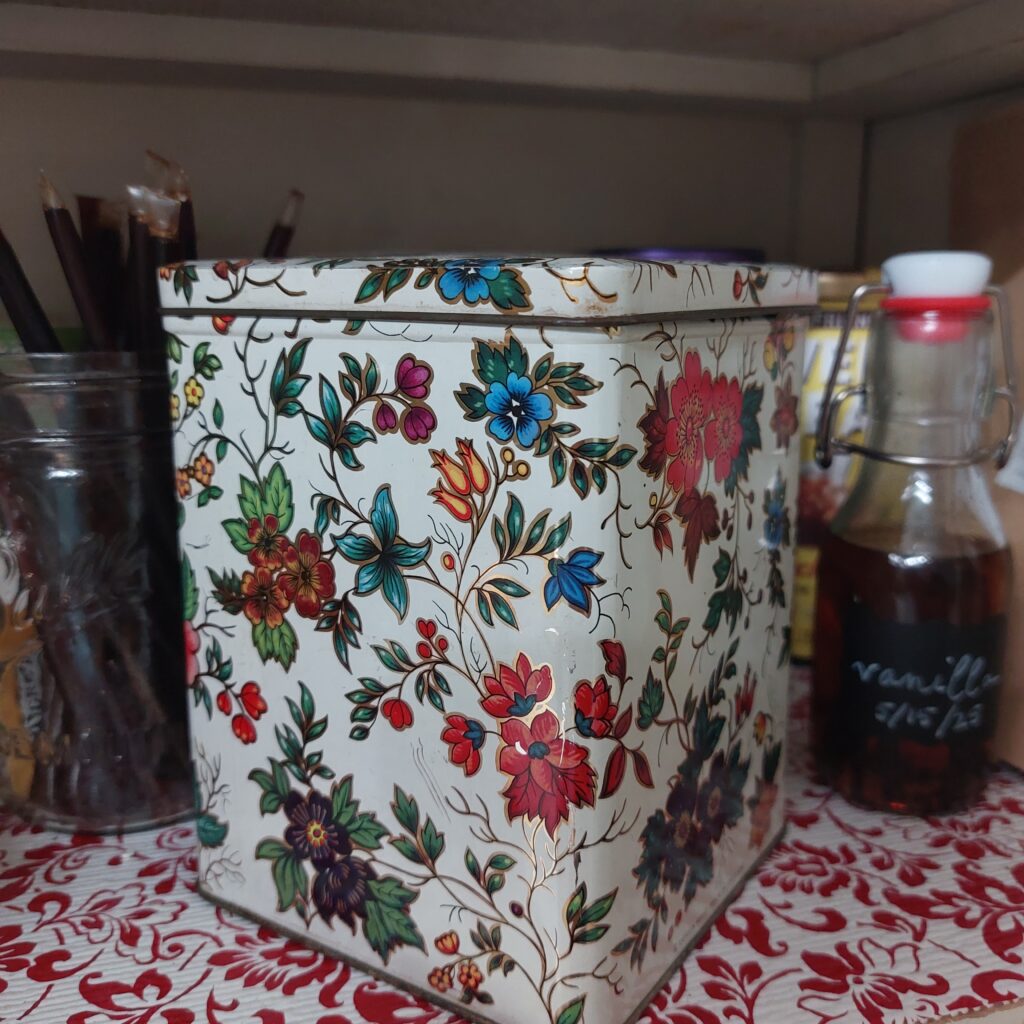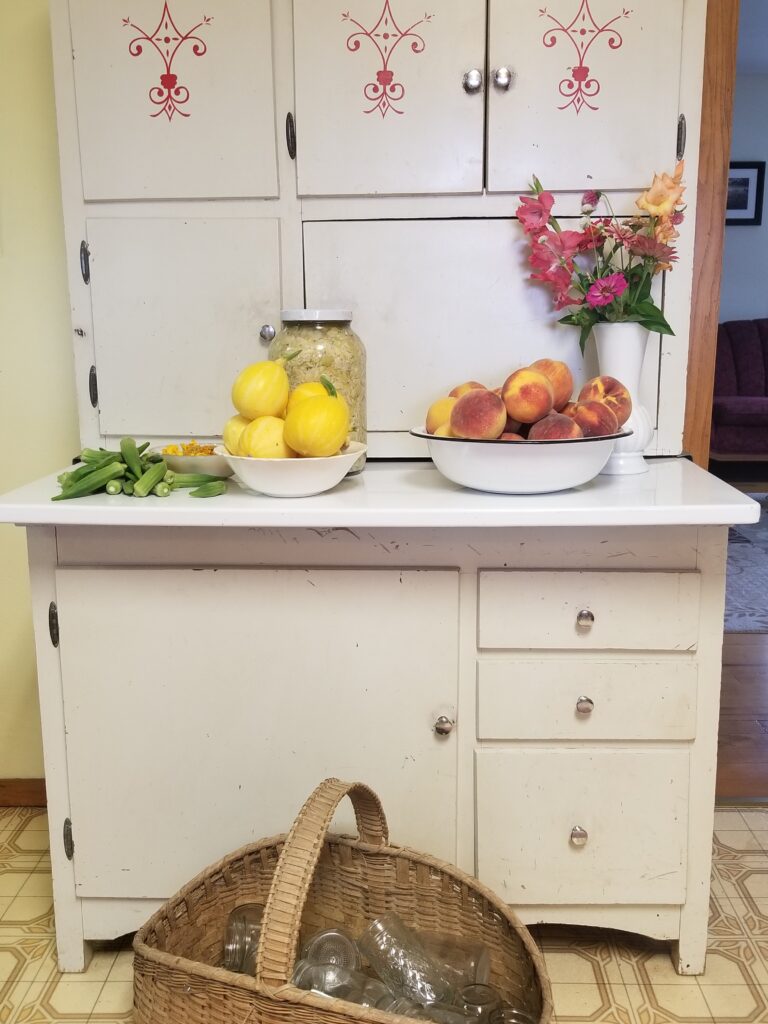Most of the time I find that the advice of “old-fashioned,” pre-1950s homemaking is still relevant to modern life. It may manifest a little differently, but at its core, many aspects are the same. One of them is shopping. In spite of a heavy emphasis in the old days on all things frugal, the advice on secondhand and thrift shopping is non-existent. It’s remarkable, really.
Once upon a time–not too terribly long ago–people’s possessions stayed with them for life unless they broke beyond repair or wore out to nothing.
I’ve read every Agatha Christie novel at least twice so they blur together sometimes. But in one of her books, a character comments that everything found at charity shops (thrift stores) are items that once belonged to people who have passed away. When a family member died, his belongings were divided among the family and anything left over–usually just clothes that didn’t fit anyone–were given away for someone so destitute they’d wear someone else’s clothing.
While there have always been secondhand furniture stores and antique shops, places that sell used everyday things is a more recent phenomenon.
My mom remembers the first time she ever saw a yard sale. It was in the late 1970s. Someone in naval housing spread their household belongings on a lawn in the hopes of selling them before moving. In the mid-1980s she stumbled onto the first clothing thrift store she’d ever seen. I’m sure they existed before then, but my point is that they weren’t a familiar way to shop.
Today, the small town where I live supports four thrift stores, not to mention the garage sales every weekend and the monthly swap meets. We have a TREMENDOUS excess of possessions in our world.
Thrift Shopping in the 1990s
(What I’m calling “thrift” shopping in this article includes thrift and secondhand stores, estate and garage sales.)
Thrifting isn’t what it used to be, sadly. At least for me, living in the upper Midwest, thrift stores in the 1990s resembled what we’d now consider a straight-up antique store. It was all gold Corelle dishes, doilies, avocado green Pyrex casseroles, Fisher Price toys, and Dick and Jane readers. For an inexplicable reason, I guess I thought they’d always be like that.
But then seemingly overnight, it changed. The old hardcover school readers were replaced by cheaply bound Scholastic books and plastic everything ruled the day.
While the overall look of a thrift store’s wares changed, it still wasn’t uncommon to run across the good old stuff. I lived in an area with a significant older population. When these elderly died, their families flooded our local shop with an inventory of the good merchandise.
I’ve learned that thrift store inventory varies radically because it mirrors what’s readily available. Age and income demographics play a huge part in the make up of a thrift store. So they’ll continue to look more and more like the merchandise in the local stores where everyone shops, just maybe a year or two behind the “trends.”
That might sound discouraging. But quality is still to be found and the worse the quality of the mass-produced stuff, the more important thrifting becomes.
Why Thrift?
Nowadays, it’s dumb not to thrift. Well, it is if you’re a family trying to make it on one income, working to pay off debt, or trying to save money. (Isn’t that just about everybody?)
Frugality. I’m cheap. I don’t like to overspend on something. I’m OK with not being the first owner of something if that means I can spend less for it. Living on one income typically means living on less money and that means you have to shop a little more creatively.
Quality. We all know the quality of the stuff nowadays. It’s horrible. Things are designed to wear out quickly so that you need to buy the next new thing on the market. And if you do happen to keep the old version around, you’ll have to give it up eventually because it won’t be compatible with anything on the market.
It’s intentional, so much so that this short-term life even has a name. Planned Obsolescence. Even not so many decades ago, things used to be made with longevity in mind. That’s why I’m still using the same top-loading, center-agitator washer that my mother-in-law was using in the 1990s. It’s precisely why I dragged it with me across the country.
And that’s also why I know the 2 year-old (used) dryer I bought when I moved here—the kind that beeps and sings and has a million features that I never use—will probably only last me a few more years.
If something has lasted long enough to outlive its usefulness to one or several owners, yet still have some life in it, it will probably last me a long time, too.
Nobody will ever look at me or my house and think I’m wealthy. Most of the reason is because I’m not. In any way. However! I look like I spend more than I really do. The essentially brand-new shoes I bought for $5 cost $80 online. The sewing machine with a desk-like cabinet complete with attachments I bought for $20. The cast iron muffin tin that I’ll use for the rest of my life that I paid $10 for.

I’m able to have real wooden furniture and quality cookware and higher end shoes than I could normally afford. But my goal isn’t about looking like I spent a lot on something that I didn’t. It goes back to quality. Buying something of quality one time means I don’t have to buy the Walmart crapola version three times over.
Originality. Have you ever walked into a house and knew that Target had thrown up everywhere? There is nothing cookie cutter about my home. I love the freedom of loving and using things from any era, not just what someone has decided is “on trend” today. Thrifting allows you to buy an eclectic variety of one-of-a-kind things that make your home reflect you.
History. Personally, I love old things. I don’t see any personality in modern mass-produced anything. But I don’t like antiques to just sit in a corner on display, I like to use them, too. I love wearing a vintage apron knowing that another woman baked cookies wearing it, too. It will crumble to nothing eventually, anyway, so it may as well get used.
Environment. This is the noble reason that justifies many a thrift purchase nowadays. Frankly, I think it’s a lot of nonsense. No one should be shopping enough to make a drop in the ocean’s difference to the depth of a landfill.
In my case in particular, the sorts of things that I look for are not the things filling dumpsters. The materials I thrift (and encourage others to do) are things like wool, linen, pottery, glass, wood– natural things that aren’t damaging the environment. I thrift in part to avoid the plastics prevalent in the big box stores; I’m not trying to give them an extra life with me.
Why People Don’t Thrift
To me, the most common (and silliest) reason is not wanting someone else’s things in your home, as if there’s some gross factor. It’s a rare item that didn’t pass through many hands before reaching yours. How many people were involved in making an item, shipping it, stocking it on a display at a store, and trying it on before you bought it?
More than once, I’ve heard people say that they can’t afford to go thrifting, as if it’s entertainment, like a pastime or hobby. They believe (and maybe rightly so) that they spend more on thrifting than they should and come home with things they really don’t need.
It’s a legitimate problem. I regularly see women with heaping carts of decor and non-essentials. I can only imagine what their houses look like. No one needs that many collectible dolls and fat chef kitchen art. I’m no expert, but they’re not reselling it, either, unless it’s at their own estate sale when they won’t be participating.
Thrifting Rules
I thrift regularly. But there are rules. And if you don’t follow them, your house WILL become overrun with stuff, i.e., junk.
Don’t base your buying decision solely on how good of a bargain it is. Everywhere you look, you’ll see what my husband calls “a screamin’ deal.” Of course it is. Just about everything is technically a good price, because someone is trying to get rid of it.
Slow down. You’re not on Supermarket Sweep. The goal is to go home with one great deal instead of a dozen mediocre ones. Even better, consider it a success when you leave a shop or sale with nothing. Pick up that item that caught your eye and carry it around if you must, but think it through logically. Do you have a specific spot for this thing? Have you really been wanting this, even before you saw it? Will you use it?
Play the long game. Be OK with working your way up to what you ultimately want. I’ve done this many times and it works.
Here’s an example: Let’s say you need something basic, for instance, a bowl. You could go online or to a kitchenware store today and drop a lot of money on your dream mixing bowl. Or, you could go out today and buy a plastic thrift store bowl for nearly nothing. So you get the plastic bowl, but keep a lookout for something better. Eventually, you’ll find a nicer stainless steel bowl that’s still a bargain. You use it until the magical day when you find that handmade ceramic mixing bowl you’ve dreamed of. And if that day never comes, you’ll know that you gave it your best try, but now you’re in a better financial state to buy a new one without regret.
Don’t let a bargain inspire a hobby or a new interest. There will come a day when you’re minding your own business and you stumble onto someone’s yarn stash, complete with pattern books and half-made afghans. Never mind that you only sorta know how to knit a washcloth, the price just seems too good to resist. Unless you’ve been seeking out knitting supplies already, it’s easy to get swept up into the possibilities. Do this a couple of more times and you’ll be overrun with projects and potential, never-realized hobbies.
Say no to “someday” projects. Don’t buy a shirt you love that doesn’t quite fit but looks like you can alter it. Unless, of course, you’re going home TODAY to work on it. Those future projects multiply in the closet and will be so overwhelming that you’ll avoid them all.
Keep lists and hold yourself to them. They can keep you focused on the necessities and not the “fun-to-haves” if you need to be extra careful with your budget. Lists are also useful for keeping track of clothing sizes for multiple people (including shoe sizes traced onto paper).
Carry cash, for many obvious reasons. Small bills and quarters especially. Many garage sales can’t take plastic and besides, it will keep you from getting carried away by bargains.
What I Thrift
Everybody has different needs. This list is by no means exhaustive, but these are my go-tos:
Linens— all kinds. Vintage cotton sheets, tablecloths, table runners, fabric napkins, aprons, pillowcases, dishtowels, potholders. You can use them for their intended purpose (heaven knows I literally burn through potholders like they’re disposable) or you can treat them as fabric and repurpose them into clothes and crafts. (Another post for another day.)
Textiles–things like wool blankets, rugs, curtains, handmade afghans
Consumables—This has become my favorite category. It’s easy to overlook consumables because they’re not unique. They don’t jump out as treasures. But actually, they’re usually huge bargains and the most useful to your budget. What do I mean by “consumables?” A few things I’ve found over the years—staples, padded mailing envelopes, lamp oil, wrapping paper, light bulbs, tea lights, cotton balls, yards of cheesecloth, clothespins and just last week, a bottle of bluing.
I once almost didn’t notice 3 big rolls of freezer paper for a couple of dollars each. 6 years later, I’m still working my way through them.
I skip all the partially-used health and beauty products. For one, I make most of my own anyway, and for two, they’re likely old and not at their best quality.
Books— Vintage books of all kinds are my particular weakness, especially cookbooks. But it’s also worthwhile to look for reference books, like medical guides, gardening books, and field guides. Sometimes it’s refreshing to look at actual paper instead of a screen. And I like to own information and not be at the mercy of changing technology, internet problems, and the popular narrative of the day.

Speaking of, technology when it comes to books is one of those blessings that’s kind of a curse. The amount of information we can access with technology is truly incredible. Many of the old obscure books I’ve read have been the digital versions, and not bought used. If there are physical copies around, they’re likely rare (expensive) and in poor shape. But digital also means ethereal. Stumble across it today and tomorrow it’s disappeared. Even if you do capture it, you’re forever dependent on a device you haven’t created and can’t repair or maintain.
But this is a post on thrifting. I’ll explain even more reasons why you should collect physical books in another post, but for today, just buy the dang books. Fill your shelves.
Jars and Containers—These are expensive in the store for what they are–storage. There’s no advantage to ever buy new. So I keep an eye out for good glass jars, especially the bail-top type. They’re good for storing pantry staples I buy in bulk. I don’t need them to match; actually, I prefer that they don’t.

A pretty tin from England made a lovely container for our drink packets. A basket on top of the fridge neatly stores all my kitchen towels and frees up some of my minimal drawer space. I keep my measuring cups and spoons in a little old-fashioned enamel pot I found at an antique mall.
Kitchenware—There’s usually such an abundance of kitchenware in any thrift store that you can play the long game and work your way into getting exactly what you want. I’m pretty pleased with the collection of kitchen tools and dishes that I’ve accumulated.
Just yesterday I found an angel food cake pan ($2) to replace the one I got rid of before a move several years ago. It turns out they’re not so plentiful in Texas thrift stores as they are in the Midwest. But I’m glad I held out. The last time I made an angel food cake was a year ago, when I borrowed a pan from the neighbor, still hoping I’d find one cheaply. And I finally did.
Some things that used to be on my list that I found over a few years have been a good heavy rolling pin, metal cookie cutters, Pyrex mixing bowls, an old-style egg beater (smooth-turning!), a metal colander, and a stainless steel butter dish for everyday use.
That doesn’t mean I’ve stopped looking for quality stuff, though, just in case. At the moment, I’m keeping an eye out for a small wooden cutting board and I’m always watching out for old cast iron pans and, it seems, every thrifter’s Holy Grail—a Le Creuset Dutch oven.
Canning Supplies– assuming you’re a gardener (since you’re thrifty) you can find everything from canners to jars to boxes of lids. Jars may not be as plentiful and as cheap as they used to be, but gardeners retire every day and their supplies need to go somewhere.
Art–Art is subjective, so maybe it’s just me that thinks a lot of the art in thrift stores is wretched. But there are gems scattered around if you keep your eyes open. Either way, “new” art of any kind isn’t cheap and new picture frames can be incredibly expensive. If you find one in the right size, you can replace it with your own art. If you don’t like the frame, you can get creative and make it work to your liking with paint or other material.
Craft/Sewing Supplies– I sew, so I always look out for yardage materials, preferably cottons, and all the other notions and supplies that I use regularly. I like to keep a few zippers in neutral colors, an assortment of buttons, interfacing, and spool thread. Embroidery floss is usually a huge bargain. I like to keep a stock of spare pins and sewing machine needles, so I look for those, too.
The Different Kinds of Thrifting Opportunities
Most people don’t even consider the classic antique store to be a thrifting option. They are, although they’ll be the most expensive option. The owners and sellers know how much things are worth in the resale market so you likely won’t find any gems for pennies. But still, when compared to new items, you can still find great quality bargains. For example, I found my Hoosier cabinet at an antique shop for less than $200. You won’t find a brand-new piece of furniture made of real wood with an enamel countertop for that price.

Thrift stores aren’t all the same and each have their own personality. They obviously mirror the local demographics. Many are name-brand “chains” like Goodwill, for example. When I lived in the rural Midwest, it wasn’t difficult to find “vintage” things at any of them. In Austin, TX, the shops had high quality, nearly new clothes, but absolutely nothing old.
Some Goodwill stores are absurdly expensive while others are more reasonable. I’ve heard that Goodwill culls the really good donations and sells them through little boutiques they own, so you typically won’t find actual antiques at your local Goodwill.
Most Salvation Army stores I’ve been to have been cheaper and lower quality and rarely my favorite stops, except for one that had the best secondhand furniture selection I’ve ever seen. You just never know!
My favorite thrift stores are the local (non-chain) thrift stores, usually run by volunteers. Their hours may be a little odd, but they’re cheaper and generally not too bogged down assessing what something could be worth on ebay. They’re trying to move things along. It seems to me that they have older, higher quality inventory than chain shops.
I also love estate sales. Family members are usually digging out a lifetime or two of things. In older, rural areas, I noticed it could mean generations of possessions, many of them forgotten and dragged out of a closet. Yes, many things are old, which I personally love, but there are many things the family member likely used every day that you don’t typically find at thrift stores. Usually, the family members want things sold and gone, so they’re not anxious to get top dollar for everything. Moving sales are also great for the same reason. People are more interested in liquidating than making a lot of money.
I’ll freely admit that a lot of garage sales these days are lousy. Many women use them to do an annual home declutter. They set up a few tables in their yard and put out a sporadic selection of leftover network marketing inventory, a few paperbacks, old (but not old enough to be interesting) Christmas decor, cheap candles, and a year’s worth of give-away event t-shirts. If my time is short, I’ll pronounce it a “drive-by” and move on without stopping. But still, you’d be surprised at how often you can find something worthwhile, even at a sub-par yard sale.
Garage/yard sales are typically the cheapest of all the ways to shop, especially when it comes to clothing. However, sifting through piles of clothes without a way to try them on first can be frustrating. That’s why it’s often the perfect place to find clothing for young children this way. People sell baby and children’s clothing for next to nothing and always seem to have it in massive quantities.
(Here’s a tip I learned just this summer from a lady at a thrift store. I noticed her doing some odd behavior but, y’know, she seemed happy and harmless enough… She’d pick up a pair of pants, drape it over her shoulders like it was a cape, and then repeat it with several more pairs. She must have felt a little self-conscious and wanted to explain her behavior because she walked over to tell me what she was doing.
This is what she told me: If you can wrap the top edge of a pair of pants or skirt around your neck and have the two ends meet, they’ll fit your waist. I’ve tried it several times with my own clothes, and it works, at least for the fit that I want. This might come in handy sometime when there isn’t a dressing room available.)
To Sum it Up
No, thrifting isn’t what it used to be. But the era of fabulous bargains and rare quality finds was brief in the history of shopping. The good news is that we live in a world where thrifting is an option and if done carefully and deliberately, it can be a massive boost to your household economy.
Discover more from A Housewife Writes
Subscribe to get the latest posts sent to your email.
2 Comments;
Your Hoosier is charming! As a volunteer at our little town’s thrift shop, I totally agree with you on all points. After all, who doesn’t love a good treasure hunt? I would add that it helps to keep a donation bag at hand and fill it regularly. As you trickle items in to your home, be sure to trickle items out.
That’s a great point that I didn’t include! If it doesn’t fit, doesn’t work in my space, or I have second thoughts, it goes into a box pretty quickly. I don’t have the space or patience anymore for “not-quite-right” things.
The temptations that I’d have to fight if I worked at a thrift store might be too much for me, though, haha!